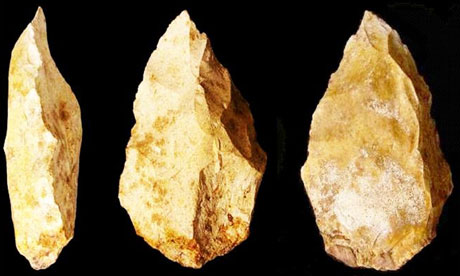 |
| Stone hand axes belonging to humans who lived in Arabia more than 100,000 years ago. Photograph: AAAS/Science/PA |
A spectacular haul of stone tools discovered beneath a collapsed rock shelter in southern Arabia has forced a major rethink of the story of human migration out of Africa. The collection of hand axes and other tools shaped to cut, pierce and scrape bear the hallmarks of early human workmanship, but date from 125,000 years ago, around 55,000 years before our ancestors were thought to have left the continent.
The artefacts, uncovered in the United Arab Emirates, point to a much earlier dispersal of ancient humans, who probably cut across from the Horn of Africa to the Arabian peninsula via a shallow channel in the Red Sea that became passable at the end of an ice age. Once established, these early pioneers may have pushed on across the Persian Gulf, perhaps reaching as far as India, Indonesia and eventually Australia.
Michael Petraglia, an archaeologist at Oxford University who was not involved in the work, told the Science journal: "This is really quite spectacular. It breaks the back of the current consensus view."
Anatomically modern humans – those that resemble people alive today – evolved in Africa about 200,000 years ago. Until now, most archaeological evidence has supported an exodus from Africa, or several waves of migration, along the Mediterranean coast or the Arabian shoreline between 80,000 and 60,000 years ago.
A team led by Hans-Peter Uerpmann at the University of Tübingen in Germany uncovered the latest stone tools while excavating sediments at the base of a collapsed overhang set in a limestone mountain called Jebel Faya, about 35 miles (55km) from the Persian Gulf coast. Previous excavations at the site have found artefacts from the iron, bronze and neolithic periods, evidence that the rocky formation has provided millennia of natural shelter for humans.
The array of tools include small hand axes and two-sided blades that are remarkably similar to those fashioned by early humans in east Africa. The researchers tentatively ruled out the possibility of other hominins having made the tools, such as the Neanderthals that already occupied Europe and north Asia, as they were not in Arabia at the time.
The stones, a form of silica-rich rock called chert, were dated by Simon Armitage, a researcher at Royal Holloway, University of London, using a technique that measured how long sand grains around the artefacts had been buried. Another strand of the archaeologists' work, described in Science, focused on climate change records and historical sea levels in the area. They show that between 200,000 and 130,000 years ago, a global ice age caused sea levels to fall by up to 100 metres, while the Saharan and Arabian deserts expanded into vast, inhospitable wastelands.
But as the climate warmed at the end of the ice age, fresh rains fell on Arabia, opening up the region to human occupation. "The previously arid interior of Arabia would have been transformed into a landscape covered largely in savannah grasses, with extensive lakes and river systems," said Adrian Parker, a researcher at Oxford Brookes University and co-author of the paper.
The revival of Arabia coincided with record lows in sea level, which left only a shallow stretch of water about three miles wide at the Bab al Mandab Straits separating east Africa and the Arabian peninsula. Uerpmann said early humans may have walked or waded across, but added: "They could have used rafts or boats, which they certainly could make at that time."
The new arrivals would have found good hunting grounds at the end of their journey, with plentiful wild asses, gazelles and mountain ibex, Uerpmann said.
The discovery has sparked debate among archaeologists, some of whom say much stronger evidence is needed to back up the researchers' claims. "I'm totally unpersuaded," Paul Mellars, an archaeologist at Cambridge University, told Science. "There's not a scrap of evidence here that these were made by modern humans, nor that they came from Africa."
Chris Stringer, a palaeontologist at the Natural History Museum in London, said: "The region of Arabia has been terra incognita in trying to map the dispersal of modern humans from Africa during the last 120,000 years, leading to much theorising in the face of few data.
"Despite the confounding lack of diagnostic fossil evidence, this archaeological work provides important clues that early modern humans might have dispersed from Africa across Arabia, as far as the Straits of Hormuz, by 120,000 years ago."
_______________
References:
Sample, Ian. 2011. "Stone tools discovered in Arabia force archaeologists to rethink human history". Guardian. Posted: January 27, 2011. Available online: http://www.guardian.co.uk/science/2011/jan/27/stone-tools-human-migration-africa?CMP=twt_fd
No comments:
Post a Comment